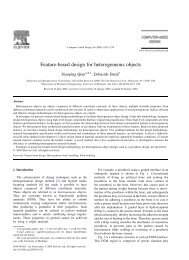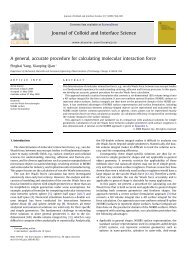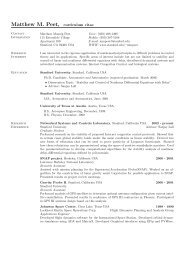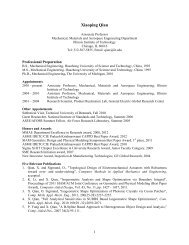Lecture 22 - Illinois Institute of Technology
Lecture 22 - Illinois Institute of Technology
Lecture 22 - Illinois Institute of Technology
You also want an ePaper? Increase the reach of your titles
YUMPU automatically turns print PDFs into web optimized ePapers that Google loves.
Stabilization via LMIs<br />
Matthew M. Peet<br />
<strong>Illinois</strong> <strong>Institute</strong> <strong>of</strong> <strong>Technology</strong><br />
<strong>Lecture</strong> <strong>22</strong>: Stabilization via LMIs
Linear Matrix Inequalities<br />
Review<br />
Linear Matrix Inequalities are <strong>of</strong>ten a Simpler way to solve control problems.<br />
Semidefinite Programming<br />
min c T x :<br />
Y 0 + ∑ i<br />
x i Y i > 0<br />
Here the Y i are symmetric matrices.<br />
Linear Matrix Inequalities<br />
Findx :<br />
Y 0 + ∑ i<br />
x i Y i > 0<br />
Commonly Takes the Form<br />
FindX :<br />
∑<br />
A i XB i + Q > 0<br />
i<br />
M. Peet <strong>Lecture</strong> <strong>22</strong>: 2 / 19
Lyapunov Theory<br />
LMIs unite time-domain and frequency-domain analysis<br />
Theorem 1 (Lyapunov).<br />
Suppose there exists a continuously differentiable function V for which V (0) = 0<br />
and V (x) > 0 for x ≠ 0. Furthermore, suppose lim ‖x‖→∞ V (x) = ∞ and<br />
V (x(t + h)) − V (x(t))<br />
lim<br />
= d<br />
h→0 + h<br />
dt V (x(t)) < 0<br />
for any x such that ẋ(t) = f(x(t)). Then for any x(0) ∈ R the system <strong>of</strong><br />
equations<br />
ẋ(t) = f(x(t))<br />
has a unique solution which is stable in the sense <strong>of</strong> Lyapunov.<br />
M. Peet <strong>Lecture</strong> <strong>22</strong>: 3 / 19
The Lyapunov Inequality<br />
Lemma 2.<br />
A is Hurwitz if and only if there exists a P > 0 such that<br />
A T P + P A < 0<br />
Pro<strong>of</strong>.<br />
Suppose there exists a P > 0 such that A T P + P A < 0.<br />
• Define the Lyapunov function V (x) = x T P x.<br />
• Then V (x) > 0 for x ≠ 0 and V (0) = 0.<br />
• Furthermore,<br />
˙V (x(t)) = ẋ(t) T P x(t) + x(t) T P ẋ(t)<br />
= x(t) T A T P x(t) + x(t) T P Ax(t)<br />
= x(t) T ( A T P + P A ) x(t)<br />
• Hence ˙V (x(t)) < 0 for all x ≠ 0. Thus the system is globally stable.<br />
• Global stability implies A is Hurwitz.<br />
M. Peet <strong>Lecture</strong> <strong>22</strong>: 4 / 19
The Lyapunov Inequality<br />
Pro<strong>of</strong>.<br />
For the other direction, if A is Hurwitz, let<br />
P =<br />
∫ ∞<br />
• Converges because A is Hurwitz.<br />
∫<br />
• Furthermore ∞<br />
P A = e AT s e As Ads<br />
=<br />
=<br />
0<br />
∫ ∞<br />
0<br />
0<br />
e AT s Ae As ds =<br />
[<br />
e AT s e As ] ∞<br />
0<br />
= −I −<br />
∫ ∞<br />
• Thus P A + A T P = −I < 0.<br />
0<br />
e AT s e As ds<br />
∫ ∞<br />
e AT s d (<br />
e<br />
As ) ds<br />
0 ds<br />
∫ ∞<br />
d<br />
−<br />
s 0 ds eAT e −As<br />
A T e AT s e −As = −I − A T P<br />
M. Peet <strong>Lecture</strong> <strong>22</strong>: 5 / 19
The Lyapunov Inequality<br />
Other Versions:<br />
Lemma 3.<br />
(A, B) is controllable if and only if there exists a X > 0 such that<br />
A T X + XA + BB T ≤ 0<br />
Lemma 4.<br />
(C, A) is stabilizable if and only if there exists a X > 0 such that<br />
AX + XA T + C T C ≤ 0<br />
These also yield Lyapunov functions for the system.<br />
M. Peet <strong>Lecture</strong> <strong>22</strong>: 6 / 19
The Static State-Feedback Problem<br />
Lets start with the problem <strong>of</strong> stabilization.<br />
Definition 5.<br />
The Static State-Feedback Problem is to find a feedback matrix K such that<br />
ẋ(t) = Ax(t) + Bu(t)<br />
u(t) = Kx(t)<br />
is stable<br />
We have already solved the problem earlier using the Controllability Grammian.<br />
• Find K such that A + BK is Hurwitz.<br />
Can also be put in LMI format:<br />
Find X > 0, K :<br />
X(A + BK) + (A + BK) T X < 0<br />
Problem: Bilinear in K and X.<br />
M. Peet <strong>Lecture</strong> <strong>22</strong>: 7 / 19
The Static State-Feedback Problem<br />
• The bilinear problem in K and X is a common paradigm.<br />
• Bilinear optimization is not convex.<br />
• To convexify the problem, we use a change <strong>of</strong> variables.<br />
Problem 1:<br />
Problem 2:<br />
Definition 6.<br />
Find X > 0, K :<br />
X(A + BK) + (A + BK) T X < 0<br />
Find P > 0, Z :<br />
AP + BZ + P A T + ZB T < 0<br />
Two optimization problems are equivalent if a solution to one will provide a<br />
solution to the other.<br />
Theorem 7.<br />
Problem 1 is equivalent to Problem 2.<br />
M. Peet <strong>Lecture</strong> <strong>22</strong>: 8 / 19
The Dual Lyapunov Equation<br />
Problem 1:<br />
Find X > 0, :<br />
Lemma 8.<br />
XA + A T X < 0<br />
Problem 1 is equivalent to problem 2.<br />
Problem 2:<br />
Find Y > 0, :<br />
Y A T + AY < 0<br />
Pro<strong>of</strong>.<br />
First we show 1) solves 2). Suppose X > 0 is a solution to Problem 1. Let<br />
Y = X −1 > 0.<br />
• If XA + A T X < 0, then<br />
• Hence<br />
X −1 (XA + A T X)X −1 < 0<br />
X −1 (XA + A T X)X −1 = AX −1 + X −1 A T = AY + Y A T < 0<br />
• Therefore, Problem 2 is feasible with solution Y = X −1 .<br />
M. Peet <strong>Lecture</strong> <strong>22</strong>: 9 / 19
The Dual Lyapunov Equation<br />
Problem 1:<br />
Find X > 0, :<br />
XA + A T X < 0<br />
Problem 2:<br />
Find Y > 0, :<br />
Y A T + AY < 0<br />
Pro<strong>of</strong>.<br />
Now we show 2) solves 1) in a similar manner. Suppose Y > 0 is a solution to<br />
Problem 1. Let X = Y −1 > 0.<br />
• Then<br />
XA + A T X = X(AX −1 + X −1 A T )X<br />
= X(AY + Y A T )X < 0<br />
Conclusion: If V (x) = x T P x proves stability <strong>of</strong> ẋ = Ax,<br />
• Then V (x) = x T P −1 x proves stability <strong>of</strong> ẋ = A T x.<br />
M. Peet <strong>Lecture</strong> <strong>22</strong>: 10 / 19
The Stabilization Problem<br />
Thus we rephrase Problem 1<br />
Problem 1:<br />
Find P > 0, K :<br />
(A + BK)P + P (A + BK) T < 0<br />
Theorem 9.<br />
Problem 1 is equivalent to Problem 2.<br />
Problem 2:<br />
Find X > 0, Z :<br />
AX + BZ + XA T + ZB T < 0<br />
Pro<strong>of</strong>.<br />
We will show that 2) Solves 1). Suppose X > 0, Z solves 2). Let P = X > 0<br />
and K = ZP −1 . Then Z = KP and<br />
(A + BK)P + P (A + BK) T = AP + P A T + BKP + P K T B T<br />
= AP + P A T + BZ + Z T B T < 0<br />
Now suppose that P > 0 and K solve 1). Let X = P > 0 and Z = KP . Then<br />
AP + P A T + BZ + Z T B T = (A + BK)P + P (A + BK) T < 0<br />
M. Peet <strong>Lecture</strong> <strong>22</strong>: 11 / 19
The Stabilization Problem<br />
The result can be summarized more succinctly<br />
Theorem 10.<br />
(A, B) is static-state-feedback stabilizable if and only if there exists some P > 0<br />
and Z such that<br />
AP + P A T + BZ + Z T B T < 0<br />
with u(t) = ZP −1 x(t).<br />
Standard Format:<br />
[ ] [ ]<br />
P A B + [ P Z ] [ ]<br />
Z<br />
T A T<br />
B T < 0<br />
There are a number <strong>of</strong> general-purpose LMI solvers available. e.g.<br />
• SeDuMi - Free<br />
• LMI Lab - in Matlab Robust Control Toolbox (in Computer lab)<br />
• YALMIP - A nice front end for several solvers (Free)<br />
M. Peet <strong>Lecture</strong> <strong>22</strong>: 12 / 19
The Schur complement<br />
Before we get to the main result, recall the Schur complement.<br />
Theorem 11 (Schur Complement).<br />
For any S ∈ S n , Q ∈ S m and R ∈ R n×m , the following are equivalent.<br />
[ ] M R<br />
1.<br />
R T > 0<br />
Q<br />
2. Q > 0 and M − RQ −1 R T > 0<br />
A commonly used property <strong>of</strong> positive matrices.<br />
Also Recall: If X > 0,<br />
• then X − ɛI > 0 for ɛ sufficiently small.<br />
M. Peet <strong>Lecture</strong> <strong>22</strong>: 13 / 19
The KYP Lemma (AKA: The Bounded Real Lemma)<br />
The most important theorem in this class.<br />
Lemma 12.<br />
Suppose<br />
Then the following are equivalent.<br />
• ‖G‖ H∞ ≤ γ.<br />
[ A B<br />
Ĝ(s) =<br />
C D<br />
• There exists a X > 0 such that<br />
[ ]<br />
A T X + XA XB<br />
B T + 1 [ ] C<br />
T [C ] D < 0<br />
X −γI γ D T<br />
]<br />
.<br />
Can be used to calculate the H ∞ -norm <strong>of</strong> a system<br />
• Originally used to solve LMI’s using graphs. (Before Computers)<br />
• Now used directly instead <strong>of</strong> graphical methods like Bode.<br />
The feasibility constraints are linear<br />
• Can be combined with other methods.<br />
M. Peet <strong>Lecture</strong> <strong>22</strong>: 14 / 19
The KYP Lemma<br />
Pro<strong>of</strong>.<br />
We will only show that ii) implies i). The other direction requires the<br />
Hamiltonian, which we have not discussed.<br />
• We will show that if y = Gu, then ‖y‖ L2 ≤ γ‖u‖ L2 .<br />
• From the 1 x 1 block <strong>of</strong> the LMI, we know that A T X + XA < 0, which<br />
means A is Hurwitz.<br />
• Because the inequality is strict, there exists some ɛ > 0 such that<br />
[ ]<br />
A T X + XA XB<br />
B T + 1 [ ]<br />
C<br />
T [C ] D<br />
X −(γ − ɛ)I γ D T<br />
[ ]<br />
A<br />
=<br />
T X + XA XB<br />
B T + 1 [ ] [ ]<br />
C<br />
T [C ] 0 0<br />
D +<br />
X −γI γ D T < 0<br />
0 ɛI<br />
• Let y = Gu. Then the state-space representation is<br />
y(t) = Cx(t) + Du(t)<br />
ẋ(t) = Ax(t) + Bu(t) x(0) = 0<br />
M. Peet <strong>Lecture</strong> <strong>22</strong>: 15 / 19
The KYP Lemma<br />
Pro<strong>of</strong>.<br />
• Let V (x) = x T Xx. Then the LMI implies<br />
[ ] [ T [A ]<br />
x(t)<br />
T X + XA XB<br />
u(t) B T + 1 X −(γ − ɛ)I γ<br />
[ ] T [ [ ]<br />
x A<br />
=<br />
T X + XA XB x<br />
u B T +<br />
X −(γ − ɛ)I] 1 [<br />
x<br />
u γ u<br />
[ ] T [ [ ]<br />
x A<br />
=<br />
T X + XA XB x<br />
u B T +<br />
X −(γ − ɛ)I] 1 u γ yT y<br />
[<br />
C<br />
T<br />
D T ] [C<br />
] ] [ ]<br />
x(t)<br />
D<br />
u(t)<br />
] T [<br />
C<br />
T<br />
D T ] [C<br />
] [ ]<br />
x D<br />
u<br />
= x T (A T X + XA)x + x T XBu + u T B T Xx − (γ − ɛ)u T u + 1 γ yT y<br />
= (Ax + Bu) T Xx + x T X(Ax + Bu) − (γ − ɛ)u T u + 1 γ yT y<br />
= ẋ(t) T Xx(t) + x(t) T Xẋ(t) − (γ − ɛ)‖u(t)‖ 2 + 1 γ ‖y(t)‖2<br />
= ˙V (x(t)) − (γ − ɛ)‖u(t)‖ 2 + 1 γ ‖y(t)‖2 < 0<br />
M. Peet <strong>Lecture</strong> <strong>22</strong>: 16 / 19
The KYP Lemma<br />
Pro<strong>of</strong>.<br />
• Now we have ˙V (x(t)) − (γ − ɛ)‖u(t)‖ 2 + 1 γ ‖y(t)‖2 < 0<br />
• Integrating in time, we get<br />
∫ T<br />
(<br />
˙V (x(t)) − (γ − ɛ)‖u(t)‖ 2 + 1 γ ‖y(t)‖2) dt<br />
0<br />
= V (x(T )) − V (x(0)) − (γ − ɛ)<br />
∫ T<br />
0<br />
‖u(t)‖ 2 dt + 1 γ<br />
• Because A is Hurwitz, lim t→∞ x(t) = 0.<br />
• Hence lim t→∞ V (x(t)) = 0.<br />
• Likewise, because x(0) = 0, we have V (x(0)) = 0.<br />
∫ T<br />
0<br />
‖y(t)‖ 2) dt < 0<br />
M. Peet <strong>Lecture</strong> <strong>22</strong>: 17 / 19
The KYP Lemma<br />
Pro<strong>of</strong>.<br />
• Since V (x(0)) = V (x(∞)) = 0,<br />
[<br />
lim ˙V (x(T )) − ˙V (x(0)) − (γ − ɛ)<br />
T →∞<br />
= 0 − 0 − (γ − ɛ)<br />
∫ ∞<br />
0<br />
‖u(t)‖ 2 dt + 1 γ<br />
= −(γ − ɛ)‖u‖ 2 L 2<br />
+ 1 γ ‖y‖2 L 2<br />
dt < 0<br />
∫ T<br />
0<br />
∫ ∞<br />
0<br />
‖u(t)‖ 2 dt + 1 γ<br />
‖y(t)‖ 2 dt<br />
∫ T<br />
0<br />
‖y(t)‖ 2) ]<br />
dt<br />
• Thus<br />
‖y‖ 2 L 2<br />
dt < (γ 2 − ɛγ)‖u‖ 2 L 2<br />
• By definition, this means ‖G‖ 2 H ∞<br />
≤ (γ 2 − ɛγ) < γ 2 or<br />
‖G‖ H∞ < γ<br />
M. Peet <strong>Lecture</strong> <strong>22</strong>: 18 / 19
The Positive Real Lemma<br />
A Passivity Condition<br />
A Variation on the KYP lemma is the positive-real lemma<br />
Lemma 13.<br />
Suppose<br />
Then the following are equivalent.<br />
[ A B<br />
Ĝ(s) =<br />
C D<br />
• G is passive. i.e. (〈u, Gu〉 L2 ≥ 0).<br />
• There exists a P > 0 such that<br />
[ ]<br />
A T P + P A P B − C T<br />
B T P − C −D T ≤ 0<br />
− D<br />
]<br />
.<br />
M. Peet <strong>Lecture</strong> <strong>22</strong>: 19 / 19
















